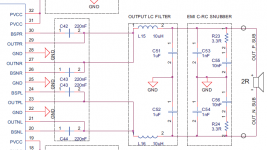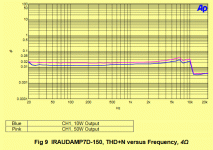I set out to select class D amp boards for my special application and thought I would share my results so far.
My application is a 14-channel amp for a digital pipe organ, handling frequencies primarily 100-8500 Hz (the lower frequencies are being handled elsewhere). My application will have output requirements of 36W/ch or less, driving 4-ohm cabinets. I am searching for the best available choice in class D boards that could provide relatively clean output (low distortion) at 36W and fit 14 channels into some sort of 19" enclosure.
My first step was to select a few boards to test. I limited the first selection to a few that sounded promising and included chips spec'd at 4 ohms. I included a range of power ratings to see what the performance differences might be. These were the boards included so far:
Sure 2x300W AA-AB32192 TAS5630 (obviously this one is on the large side)
YJ 2x100W TDA8920
YJ Mono 200W IRS2092
YJ 2x50W TPA3116
XH-M542 Mono 100W TPA3116 (this one is very small)
You will recognize many of these in the photo below. I wanted to test all the boards as-is out of the box first, no mods. The only changes I made were:
- For the BTL boards, I added a ground connection near the output to facilitate connection to my class-D measurement filters.
- For the YJ Mono 200W IRS2092, I lowered the Under Voltage Protection zener to 20V. Out of the box, this board shuts down with anything less than +/- 39V (contrary to what the website says!). My bench supply only goes up to +/- 32 V.
My application is a 14-channel amp for a digital pipe organ, handling frequencies primarily 100-8500 Hz (the lower frequencies are being handled elsewhere). My application will have output requirements of 36W/ch or less, driving 4-ohm cabinets. I am searching for the best available choice in class D boards that could provide relatively clean output (low distortion) at 36W and fit 14 channels into some sort of 19" enclosure.
My first step was to select a few boards to test. I limited the first selection to a few that sounded promising and included chips spec'd at 4 ohms. I included a range of power ratings to see what the performance differences might be. These were the boards included so far:
Sure 2x300W AA-AB32192 TAS5630 (obviously this one is on the large side)
YJ 2x100W TDA8920
YJ Mono 200W IRS2092
YJ 2x50W TPA3116
XH-M542 Mono 100W TPA3116 (this one is very small)
You will recognize many of these in the photo below. I wanted to test all the boards as-is out of the box first, no mods. The only changes I made were:
- For the BTL boards, I added a ground connection near the output to facilitate connection to my class-D measurement filters.
- For the YJ Mono 200W IRS2092, I lowered the Under Voltage Protection zener to 20V. Out of the box, this board shuts down with anything less than +/- 39V (contrary to what the website says!). My bench supply only goes up to +/- 32 V.
Attachments
Next step was to select the performance tests of interest. These are documented in the attached results. The tests I selected were what I thought would be relevant to my application (they may not be relevant to yours!).
I included a Crown D-45 class AB amp in the testing for a reference point. This amp is spec’d as extremely linear, with the fancy front panel light to indicate more than 0.05% THD and all. Its purposes were to help compare the performance of class D amps in general, and to help establish the lower limits of my equipment’s ability to measure noise and distortion (each piece of my equipment in this setup had only a 3-digit price US).
My overall impressions so far is that, with the exception of the $6 tiny board, all the boards I selected were pretty similar in performance, some better on certain tests than others. All performed noticeably poorer than the Crown amp, as expected. It was interesting though to quantify this difference a bit, within the limits of my test setup.
Next step will be to do some listening tests, and try to correlate what I hear to the measurements, if even possible.
I included a Crown D-45 class AB amp in the testing for a reference point. This amp is spec’d as extremely linear, with the fancy front panel light to indicate more than 0.05% THD and all. Its purposes were to help compare the performance of class D amps in general, and to help establish the lower limits of my equipment’s ability to measure noise and distortion (each piece of my equipment in this setup had only a 3-digit price US).
My overall impressions so far is that, with the exception of the $6 tiny board, all the boards I selected were pretty similar in performance, some better on certain tests than others. All performed noticeably poorer than the Crown amp, as expected. It was interesting though to quantify this difference a bit, within the limits of my test setup.
Next step will be to do some listening tests, and try to correlate what I hear to the measurements, if even possible.
Attachments
Good comparison, thanks.
Increased THD for the 3116 boards will most likely suffer from these inductors. (The mono board is made for 8R, so it will measure better at this load resistance i'd guess)
Increased THD for the 3116 boards will most likely suffer from these inductors. (The mono board is made for 8R, so it will measure better at this load resistance i'd guess)
Are you sure about that? The 3116 datasheet shows mono mode as a PBTL configuration, good down to 2R (see below). I was assuming the XH-M542 board was set up this way. But I haven't taken off the heat sink yet - I really have no idea yet whether it even has a real chip given the price.
Attachments
These inductors are 33uH from the printing on them. So 33uH/680nF is usually used for 8-16R if remember correctly.
All performed noticeably poorer than the Crown amp, as expected.
Not so sure for the IRS2092 based on the performance of the reference design. It suggests THD @ 1 kHz should be comparable to the Crown. Implementation maybe?
Attachments
The Crown spec says:
"Total Harmonic Distortion (THD): Less than 0.001% at full bandwidth FTC power from 20 Hz to 400 Hz increasing linearly to 0.05% at 20 kHz." If you take "linearly" super literally, that would be y0+(x-x0)*(y1-y0)/(x1-x0) = 0.0025% at 1k. With instead a log interpretation of the frequency scale, it would be 0.0125%. Either interpretation of their spec is lower than 0.02% at 1k. But... the Crown spec is for THD, not THD+N. So maybe the specs would indeed be very close. The reference design for the IRS2092 looks quite good, very impressive.
So for an $18 board, yes it probably is the implementation!
"Total Harmonic Distortion (THD): Less than 0.001% at full bandwidth FTC power from 20 Hz to 400 Hz increasing linearly to 0.05% at 20 kHz." If you take "linearly" super literally, that would be y0+(x-x0)*(y1-y0)/(x1-x0) = 0.0025% at 1k. With instead a log interpretation of the frequency scale, it would be 0.0125%. Either interpretation of their spec is lower than 0.02% at 1k. But... the Crown spec is for THD, not THD+N. So maybe the specs would indeed be very close. The reference design for the IRS2092 looks quite good, very impressive.
So for an $18 board, yes it probably is the implementation!
- Status
- Not open for further replies.
- Home
- Amplifiers
- Class D
- Comparison of (5) Class-D amp boards


